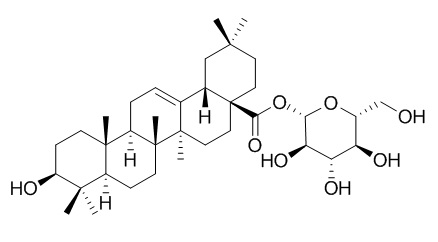Beta-D-glucopyranosyl oleanolate
Beta-D-glucopyranosyl oleanolate is a natural product from Hedera nepalensis.
Inquire / Order:
manager@chemfaces.com
Technical Inquiries:
service@chemfaces.com
Tel:
+86-27-84237783
Fax:
+86-27-84254680
Address:
1 Building, No. 83, CheCheng Rd., Wuhan Economic and Technological Development Zone, Wuhan, Hubei 430056, PRC
Providing storage is as stated on the product vial and the vial is kept tightly sealed, the product can be stored for up to
24 months(2-8C).
Wherever possible, you should prepare and use solutions on the same day. However, if you need to make up stock solutions in advance, we recommend that you store the solution as aliquots in tightly sealed vials at -20C. Generally, these will be useable for up to two weeks. Before use, and prior to opening the vial we recommend that you allow your product to equilibrate to room temperature for at least 1 hour.
Need more advice on solubility, usage and handling? Please email to: service@chemfaces.com
The packaging of the product may have turned upside down during transportation, resulting in the natural compounds adhering to the neck or cap of the vial. take the vial out of its packaging and gently shake to let the compounds fall to the bottom of the vial. for liquid products, centrifuge at 200-500 RPM to gather the liquid at the bottom of the vial. try to avoid loss or contamination during handling.
Oncotarget.2017, 8(53):90925-90947
Int J Mol Sci.2021, 22(9):5012.
Analytical Letters.2020, doi 10.1008
Analytical Letters 2021, 54(4).
J Cachexia Sarcopenia Muscle.2022, 13(6):3149-3162.
Revista Brasileira de Farmacognosia2024, 34:1156-1165.
Nanjing University of Chinese Medicine2022, 345930.
Fermentation2023, 9(10), 889
Bull. Pharm. Sci., Assiut University2020, 43(2):149-155.
Molecules.2023, 28(2):727.
Related and Featured Products
Chem Pharm Bull (Tokyo). 2000 Jun;48(6):889-92.
Saponins of plants of Panax species collected in Central Nepal, and their chemotaxonomical significance. III.[Pubmed:
10866157]
Panax pseudo-ginseng subsp. pseudo-ginseng has a carrot like root with a small rhizome.
METHODS AND RESULTS:
It was shown that the saponin composition of roots and rhizomes of this subspecies collected in Tibet and China was extremely poor. From the roots and rhizomes collected in Central Nepal, (specimen-PNct), only a small amount of an oleanolic acid saponin, Beta-D-glucopyranosyl oleanolate (2) was isolated together with a polyacetylene-alcohol, panaxynol (3). In another specimen (specimen-PNs), also collected in Central Nepal, two oleanolic acid saponins, stipleanoside R2 (4) and chikusetsusaponin IV (5) were detected. No dammarane saponin was identified in either specimen. P. pseudo-ginseng subsp. himalaicus (Subsp-H) has a big rhizome with a small round root. From rhizomes and roots of this subsp. collected in Central Nepal (specimen-HNct), a fairly large amount of dammarane saponins, ginsenosides-Rb1 (6), -Rd (7), -Re (9) and -Rg1 (10), gypenoside XVII (8), notoginsenoside-R1 (11), majonoside-R2 (12) and pseudo-ginsenoside-F11 (13) were isolated, while no oleanane saponin (oleanolic acid saponin) was identified in this subsp.
CONCLUSIONS:
Based on the present and previous studies, medicinal evaluation and chemogeographical correlation of Himalayan Panax spp. are discussed.



